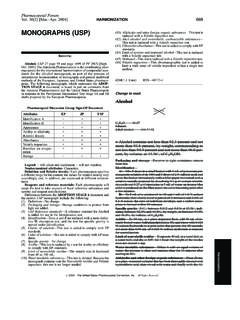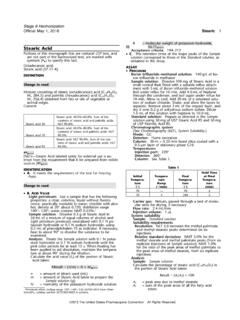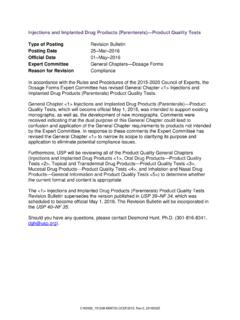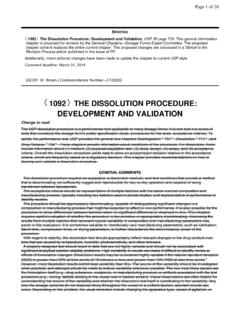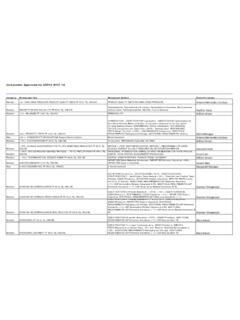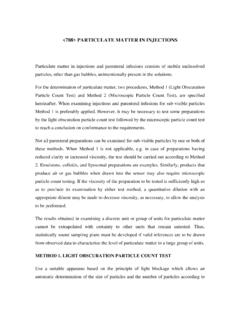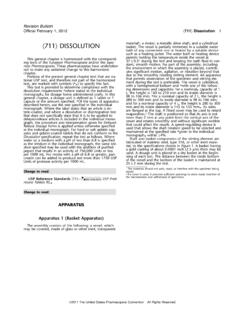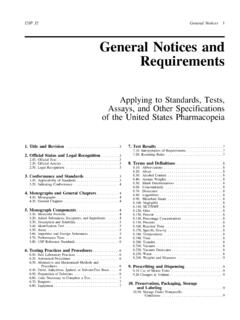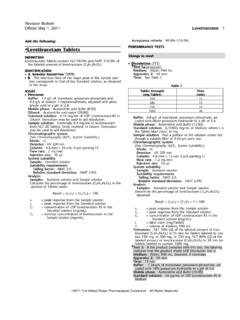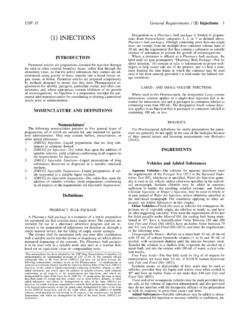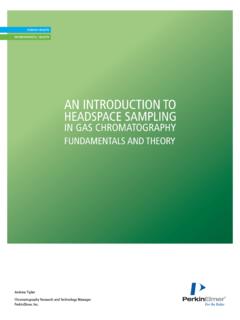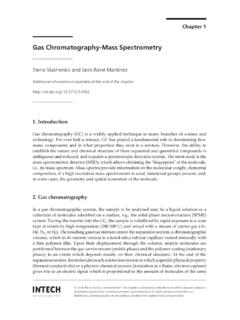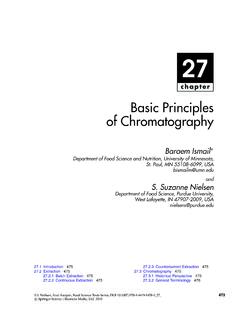Transcription of Residual Solvents: ICH Q3C Impurities: Residual Solvents
1 Residual SolventsResidual SolventsICH Q3C impurities : Residual SolventsContract Laboratories PerspectivesAssad J. Kazeminy, and CEO of Irvine Analytical Laboratories, SolventsResidual SolventszThis Session will address the implementation of ICH Residual Solvents requirements by USP and PhEur from perspective of CRO: Solvent Classification Interaction between Laboratory and API Manufacturer Selection of Methodologies Screening methodologies Method Validation Routine vs. Qualification testing Past Chromatographic Challenges Case StudiesIntroductionIntroduction Residual Solvents have had official limits in the United States as set in USP 30 <467> and by the FDA in 1997 and have been monitored by most pharmaceutical manufacturers extensively for more than two decades in both bulk and finished products.
2 Residual process Solvents in pharmaceutical samples are monitored using gas chromatography (GC) with either flame ionization detection (FID) or mass spectrometry. Based on good manufacturing practices, measuring Residual Solvents is mandatory for the release testingof all active pharmaceutical ingredients and is routinelyperformed on samples of process intermediates. On Jan 1, 2007 title of Chapter <467> will be changed to Residual introduction techniques include both static and dynamic headspace analysis, solid -phase microextraction , and direct injection of solution containing bulk drug substance or drug product into the gas conclusion, gas chromatograph-based procedures will continue to dominate Residual solvent testing because of its specificity foridentification of the solvent, but the use of alternative sample introduction techniques into a gas chromatograph will continue to expand in the near of Residual Solvents by Risk Classification of Residual Solvents by Risk AssessmentAssessmentSolvents were evaluated for their possible risk to human health and placed into one of three classes as follows.
3 Class 1 Solvents : Solvents to be avoided-Known human carcinogens, strongly suspected human carcinogens, and environmental hazards. Class 2 Solvents : Solvents to be limited-Nongenotoxic animal carcinogens or possible causative agents of other irreversible toxicity such as neurotoxicity or teratogenicity. Solvents suspected of other significant but reversible toxicities. Class 3 Solvents : Solvents with low toxic potential- Solvents with low toxic potential to man; no health-based exposure limit is needed. Class 3 Solvents have PDE's of 50 milligrams (mg) or more per dayInteraction between CRO and SponsorInteraction between CRO and SponsorIn order to launch and complete studies successfully the following steps are recommended: Project Initiation Provide CRO with DMF information and/or Physico/Chemical properties of the API Provide limits for each known Residual solvent to CRO if Testing Drug Product (Based on TDI) Agree on choice of technology to be utilized in support of testing (GC-FID or GC/MS) Is prescreening required?
4 API Qualification or routine Testing? Method Validation ScopeInteraction between CRO and SponsorInteraction between CRO and Sponsor Method Transfer CRO required to review validation report Feasibility Write protocol Generally, selectivity, LOD/LOQ and Repeatability CRO will provide Final report for review and approval Routine Analysis Always start with USP <467> procedure A Upon completion of studies CRO will provide C of A and Raw data if deemed between CRO and SponsorInteraction between CRO and Sponsor Screening Method It is recommended to perform chromatographic profile for API which Residual solvent are not known and/or their respective limits are not known. Generally GC/MS equipped with Head Space analyzer is recommended Due to its greater sensitivity Greater selectivity In addition to chromatographic profile, following studies need to be evaluated: LOD/LOQ RepeatabilityInteraction between CRO and SponsorInteraction between CRO and Sponsor Follow USP Procedure A If peak response of any peak in Test solution is to either peak in Class I and or Class II proceed to procedure B for ID Follow USP Procedure C for accurate quantitation of known Residual solventsInteraction between CRO and SponsorInteraction between CRO and SponsorzMethod ValidationzUpon completion of screening method, the method needs to be Validated as follow.
5 Selectivity Linearity from LOQ to 120% of specified limit for each solvent LOD/LOQ for standards and Spiked sample Repeatability Intermediate Precision Accuracy: 80 to 120% of each solvent Robustness GC Head Space Interaction between CRO and SponsorInteraction between CRO and SponsorQualification of API Qualify each API by evaluating 3 consecutive lots of API If multiple vendors of API are available, perform repeatability in triplicate preparation for each vendor This work is performed only once Upon completion of API qualification, test future lots by analyzing samples in triplicate preparationInteraction between CRO and SponsorInteraction between CRO and SponsorzRoutine API TestingzPerform Routing Testing as follow: Chromatographic non-interference LOD/LOQ System Suitability Bracketing Standards Sample (n=3) Blank Bracketing StandardSelection of MethodologiesSelection of Methodologies To determine Residual Solvents , many quality-control labs in pharmaceutical manufacturing employ GC-FID for the determination of Residual Solvents that are included in either USP <467> or ICH guidelines.
6 Because some of the Solvents co-elute, these labs must use at least two different separation phases . Co-elution is not a problem with mass spectrometric detection, as most co-eluting analytes have unique ions. The mass spectrometer also provides a means to identify unknown or unexpected contaminants. With the 5975 inert Mass Selective Detector (MSD), a single analysis provides both selected ion monitoring (SIM) for sensitive quantitation and full-scan spectra for identification of of MethodologiesSelection of Methodologies According to published list in ICH Q3C , there are 61 Solvents . This list would be a challenge for separation on any single GC phase , as critical coelution will be inevitable. In ICH guideline, Residual Solvents are grouped based on their toxicity, both class I and class 2 need to be analyzed by sensitive and specific methodologies.
7 However, class 3could be assayed by non-specific techniques, such as weight loss on drying <731>, due to their low of MethodologiesSelection of Methodologies Due to the advance in head space technology-mainly dynamic sampling techniques, and dual column capability faster analysis, better sensitivity and specificity is possible (MACH system allows up to 4 columns). Restek group has reported separation of 23 Residual Solvents in 8 min by utilizing dual column separation on MACH system. MACH is an Agilent GC 6890 equipped with Gerstel Modular Accelerated ColumnHeater (MACH)Figure 1. Agilent GC/MS equipped with Head Space AnalyzerAgilent Technologies, 6890N Network GC system, MS: Agilent Technologies, 5975 inert XL Mass Selective Detector Data aAnalysis: Software: G1701DA ChemStation, Figure 2.
8 CTC Autosampler System for Headspace and Liquid Challenges 1 Past Challenges 1 USP OVI Method IV for Class II SolventsUSP OVI Method IV for Class II Solvents Two early eluting extraneous peaks were detected on sample chromatogram. Upon laboratory investigation it was determined that these two peaks were reproducible and are process Solvents from API. In API Technical Package there was no information about those two Unknown peaks. Further investigation is pending .zPast Challenges 1 Past Challenges 1 USP OVI Method IV for Class II SolventsUSP OVI Method IV for Class II SolventsChromatogram 1 Methylene Chloride1,4-DioxaneTrichlorometheneChlor oformUnknown PeaksSampleStandardPast Challenges 2 Past Challenges 2 USP OVI Method IV for Class II SolventsUSP OVI Method IV for Class II Solvents One Late eluting extraneous peak was detected on sample chromatogram.
9 Laboratory Investigation suggested that Unknown peak is present in every sample preparation of API (Same Lot). In API Technical Package there was no information about this Unknown peak. Further investigation is pendingPast Challenges 2 Past Challenges 2 USP OVI Method IV for Class II SolventsUSP OVI Method IV for Class II SolventsChromatogram 2 Chloroform1,4-DioxaneTrichlorometheneMet hylene ChlorideSampleStandardUnkown PeakPast Challenges IIIPast Challenges IIIUSP OVI Method I for Class II SolventsUSP OVI Method I for Class II Solvents One early eluting extraneous peak was detected on sample chromatogram. Laboratory Investigation suggested that Unknown peak is present in every sample preparation of API (Same Lot). In API Technical Package there was no information about this Unknown peak.
10 No attempt was made for Identification of Unknown Challenges 3 Past Challenges 3 USP OVI Method IV for Class II SolventsUSP OVI Method IV for Class II SolventsChromatogram 3 Methylene ChlorideChloroformTrichloroethyleneChlor oformMethylene ChlorideChloroform1,4-DioxaneUnknown PeakStandardSamplePast ChallengesPast ChallengeszLesson Learned Perform API Screening by Utilizing GC/MS Ask for DMF Qualify your APIP ublished Methodologies in USPP ublished Methodologies in USPP rocedure A (Profiling) for Procedure A (Profiling) for WaterWater--Soluble ArticleSoluble ArticlezClass 1 and Class 2 Residual Solvents Chromatographic Conditions: x 30 m fused-silica column coated with m layer of G43or mm x 30m wide-bore column coated with m layer of G43 Carrier:He or N2 with linear velocity of 35 cm/sec and split ratio of 1:5 Column temperature:50 C 6 C /min--165 C hold for 20 minInjection port:140 CDetector Temperature: FID @ 250 C Method of Injection:Static Head SpaceNote: USP Residual Solvent standards are availablePublished Methodologies in USPP ublished Methodologies in USPP rocedure B (Peak ID)Procedure B (Peak ID)zClass 1 and Class 2 Residual SolventszChromatographic Conditions:GC- x 30 m fused-silica column coated with m layer of G16or mm x 30m wide-bore column coated with m layer of G16 Carrier.
